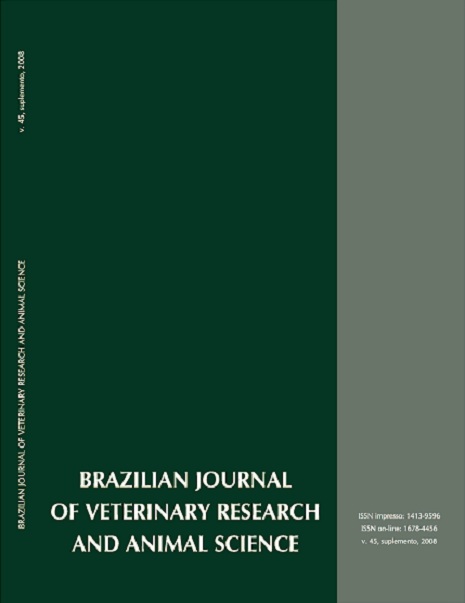Identification of ivermectin and doramectin-resistant Cooperia punctata (Linstow, 1907) in a dairy herd in the State of Rio de Janeiro, Brazil
DOI:
https://doi.org/10.11606/S1413-95962008000700010Keywords:
Resistant, Ivermectin, Doramectin, Cooperia, BovineAbstract
Anthelmintic resistance is a potential problem to nematodes controlin cattle and may cause economic loss in the dairy and beef cattleindustries. The objetive of this study was to determinate the efficacy of ivermectin, doramectin and abamectin in naturally and experimentally infected calves for Cooperia punctata in a brazilian dairy herd. Faecal egg count reduction tests were carried out employing naturally infected calves that were treated with injectable solutions of ivermectin, doramectin and abamectin. Faecal samples were collected on the day of the treatment, day 0, and at 7 and 14 days after treatment and larvae culture were made in the positive samples. A control test was carried out using 18 artificially infected calves, alocatted in three groups with six animals each: Group I - control, no treatment; Group II - ivermectin, injectable solution, 200 µg/kg; Group III - doramectin, injectable solution, 200 µg/kg. Faecal samples were collected on day of the treatment, day 0, and at 3, 7, 9 and 14 days after treatment. On days 14, 15 and 16, two animals of each group were slaughtered and their lung and gastrointestinal parasite burdens determined. The results of faecal egg count reduction tests using naturally infected calves showed a reduction percentage at 14 day after treatment from -4.45 to 11.49% for ivermectin; 32.31 to 60.40% for doramectin and 85,05% for abamectin. The only parasite identified in the larvae culture was Cooperia spp. Control test showed a faecal egg count reduction percentage at 14 day after treatment of 51.47% and 96.08% for ivermectin and doramectin, respectively. Reduction of adult worm counts in this control test was of 53.91% and 82.43% for ivermectin and doramectin, respectively. Only C. punctata was recovered in the necropsies. Thus, this C. punctata strain was considered resistant to ivermectin and doramectin treatments and suggest a possible resistance to abamectin treatment by faecal egg count reduction tests.Downloads
Download data is not yet available.
Downloads
Published
2008-12-01
Issue
Section
UNDEFINIED
License
The journal content is authorized under the Creative Commons BY-NC-SA license (summary of the license: https://
How to Cite
1.
Cardoso JMS, Martins IVF, Sant'anna FB, Correia TR, Tancredi IP, Coumendouros K, et al. Identification of ivermectin and doramectin-resistant Cooperia punctata (Linstow, 1907) in a dairy herd in the State of Rio de Janeiro, Brazil. Braz. J. Vet. Res. Anim. Sci. [Internet]. 2008 Dec. 1 [cited 2024 Apr. 20];45(supl.):75-81. Available from: https://www.revistas.usp.br/bjvras/article/view/26732





